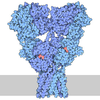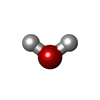Entry Database : PDB / ID : 9da9Title Crystal structure of GluN1/GluN2A agonist-binding domains in complex with 7CKA and glutamate Glutamate receptor ionotropic, NMDA 1 Glutamate receptor ionotropic, NMDA 2A Keywords / Function / homology Function Domain/homology Component
/ / / / / / / / / / / / / / / / / / / / / / / / / / / / / / / / / / / / / / / / / / / / / / / / / / / / / / / / / / / / / / / / / / / / / / / / / / / / / / / / / / / / / / / / / / / / / / / / / / / / / / / / / / / / / / / / / / / / / / / / / / / / / / / / / / / / / / Biological species Rattus norvegicus (Norway rat)Method / / / Resolution : 2.05 Å Authors Bosco, J. / Yates-Hansen, C.K. / McClelland, L.J. / Voronina, E. / Hansen, K.B. Funding support Organization Grant number Country National Institutes of Health/National Institute of Neurological Disorders and Stroke (NIH/NINDS) NS097536 National Institutes of Health/National Institute of Neurological Disorders and Stroke (NIH/NINDS) NS116055 National Institutes of Health/National Institute of General Medical Sciences (NIH/NIGMS) GM140963 National Institutes of Health/National Institute of General Medical Sciences (NIH/NIGMS) GM109053
Journal : Sci Rep / Year : 2025Title : A galactose-based auto-expression system improves T7-inducible protein production in Escherichia coli.Authors: Bosco, J. / Gagliano, E. / Boshae, K.L. / Statz, J.P. / Wheeler, T.B. / Cuello, D. / Sliter, A. / Newby, C. / Lin, B. / Demeler, A. / Pierpont, C.L. / Yates-Hansen, C. / Sydor, M.J. / ... Authors : Bosco, J. / Gagliano, E. / Boshae, K.L. / Statz, J.P. / Wheeler, T.B. / Cuello, D. / Sliter, A. / Newby, C. / Lin, B. / Demeler, A. / Pierpont, C.L. / Yates-Hansen, C. / Sydor, M.J. / Ferrini, M.E. / Kuch, K.C. / Cooper, B.S. / Piggott, B.J. / Certel, S.J. / Hansen, K.B. / Sprang, S.R. / Bowler, B. / McClelland, L. / Berkmen, M. / Voronina, E. History Deposition Aug 22, 2024 Deposition site / Processing site Revision 1.0 Mar 12, 2025 Provider / Type Revision 1.1 Mar 26, 2025 Group / Category / citation_authorItem _citation.journal_abbrev / _citation.journal_id_ASTM ... _citation.journal_abbrev / _citation.journal_id_ASTM / _citation.journal_id_CSD / _citation.journal_id_ISSN / _citation.journal_volume / _citation.page_first / _citation.page_last / _citation.pdbx_database_id_PubMed / _citation.title Revision 1.2 Apr 16, 2025 Group / Category / Item
Show all Show less
 Yorodumi
Yorodumi Open data
Open data Basic information
Basic information Components
Components Keywords
Keywords Function and homology information
Function and homology information
 X-RAY DIFFRACTION /
X-RAY DIFFRACTION /  SYNCHROTRON /
SYNCHROTRON /  MOLECULAR REPLACEMENT / Resolution: 2.05 Å
MOLECULAR REPLACEMENT / Resolution: 2.05 Å  Authors
Authors United States, 4items
United States, 4items  Citation
Citation Journal: Sci Rep / Year: 2025
Journal: Sci Rep / Year: 2025 Structure visualization
Structure visualization Molmil
Molmil Jmol/JSmol
Jmol/JSmol Downloads & links
Downloads & links Download
Download 9da9.cif.gz
9da9.cif.gz PDBx/mmCIF format
PDBx/mmCIF format pdb9da9.ent.gz
pdb9da9.ent.gz PDB format
PDB format 9da9.json.gz
9da9.json.gz PDBx/mmJSON format
PDBx/mmJSON format Other downloads
Other downloads 9da9_validation.pdf.gz
9da9_validation.pdf.gz wwPDB validaton report
wwPDB validaton report 9da9_full_validation.pdf.gz
9da9_full_validation.pdf.gz 9da9_validation.xml.gz
9da9_validation.xml.gz 9da9_validation.cif.gz
9da9_validation.cif.gz https://data.pdbj.org/pub/pdb/validation_reports/da/9da9
https://data.pdbj.org/pub/pdb/validation_reports/da/9da9 ftp://data.pdbj.org/pub/pdb/validation_reports/da/9da9
ftp://data.pdbj.org/pub/pdb/validation_reports/da/9da9 F&H Search
F&H Search Links
Links Assembly
Assembly
 Components
Components



 X-RAY DIFFRACTION / Number of used crystals: 1
X-RAY DIFFRACTION / Number of used crystals: 1  Sample preparation
Sample preparation SYNCHROTRON / Site:
SYNCHROTRON / Site:  SSRL
SSRL  / Beamline: BL12-2 / Wavelength: 0.97946 Å
/ Beamline: BL12-2 / Wavelength: 0.97946 Å Processing
Processing MOLECULAR REPLACEMENT / Resolution: 2.05→33.97 Å / SU ML: 0.2435 / Cross valid method: FREE R-VALUE / σ(F): 1.34 / Phase error: 23.6537
MOLECULAR REPLACEMENT / Resolution: 2.05→33.97 Å / SU ML: 0.2435 / Cross valid method: FREE R-VALUE / σ(F): 1.34 / Phase error: 23.6537  Movie
Movie Controller
Controller


 PDBj
PDBj









